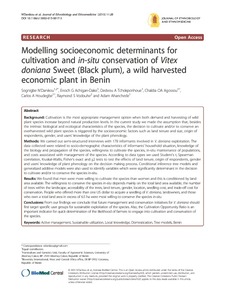Resource information
Background: Cultivation is the most appropriate management option when both demand and harvesting of wild plant species increase beyond natural production levels. In the current study we made the assumption that, besides the intrinsic biological and ecological characteristics of the species, the decision to cultivate and/or to conserve an overharvested wild plant species is triggered by the socioeconomic factors such as land tenure and size, origin of respondents, gender, and users’ knowledge of the plant phenology.
Methods: We carried out semi-structured interviews with 178 informants involved in V. doniana exploitation. The data collected were related to socio-demographic characteristics of informants’ household situation, knowledge of the biology and propagation of the species, willingness to cultivate the species, in-situ maintenance of populations, and costs associated with management of the species. According to data types we used Student’s t, Spearman correlation, Kruskal-Wallis, Fisher’s exact and ?2 tests to test the effects of land tenure, origin of respondents, gender and users’ knowledge of plant phenology on the decision making process. Conditional inference tree models and generalized additive models were also used to identify variables which were significantly determinant in the decision to cultivate and/or to conserve the species in-situ.
Results: We found that men were more willing to cultivate the species than women and this is conditioned by land area available. The willingness to conserve the species in-situ depends mainly on the total land area available, the number of trees within the landscape, accessibility of the trees, land tenure, gender, location, seedling cost, and trade-off cost for conservation. People who offered more than one US dollar to acquire a seedling of V. doniana, landowners, and those who own a total land area in excess of 6.5 ha were most willing to conserve the species in-situ.
Conclusions: From our findings we conclude that future management and conservation initiatives for V. doniana should first target specific user groups for sustainable exploitation of the species. Also, the Cultivation Opportunity Ratio is an important indicator for quick determination of the likelihood of farmers to engage into cultivation and conservation of the species.


